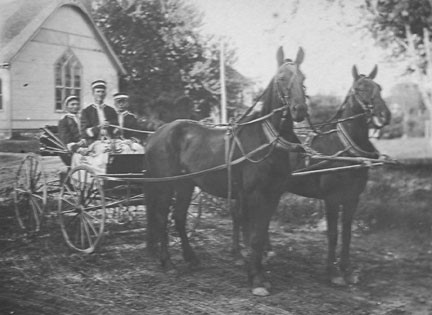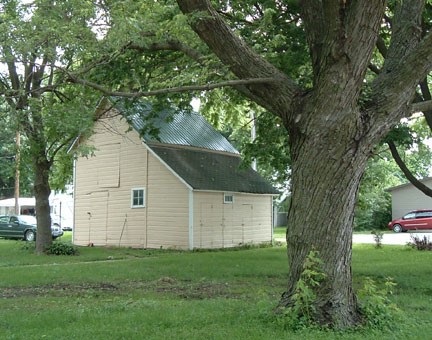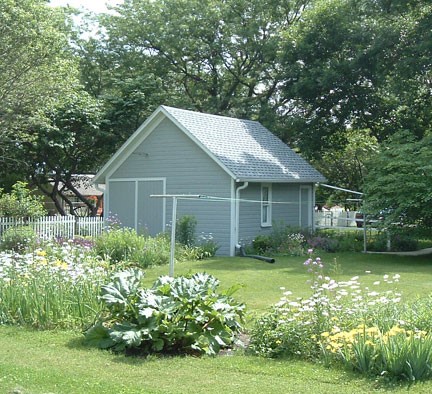WALNUT’S “BUGGY BARNS”
BY BOB GREENWALL
Our look at what we call “buggy barns” is a work in progress. When Jim Hansen and I drove the alleys of Walnut to survey these survivors of the “horse and buggy days,” we encountered more questions than answers. That would be normal for genealogist / historians, but we were both convinced that this is an interesting topic.
This article might serve as part of the process in drawing out facts that people remember about these barns. That was the case at our September meeting, when some interesting reminiscences came to light from our members. Before we get to that, we need to set some parameters for what distinguishes a “buggy barn” from, say, an ordinary garage. By the way, in the cities the same structures are called “carriage houses.”
The basic criterion, we suggest, is a haymow. Cars do not require hay. On that basis alone, we can be quite sure that plenty of the structures we looked at once served the purpose of horse-drawn transportation and therefore represent an era that is fading fast from memory and needs to be noted and preserved for future generations.
If that building behind the house is tall enough to include space above its first floor ceiling to hold hay, and if there is a door to the outside to allow hay to be pitched in, we probably have a buggy barn. There are quite a few examples just like that in Walnut. Now, some cases are marginal. For example, some have been re-sided and the hay door may have been covered over. Some have a door, but there seems to be very little space for hay. A member reminded us that not every family had a team of horses; some were “one-horse” affairs. Have you heard the phrase “a one-horse town”?
Then, there is the subject of buggy doors. The finest examples have a drive-through arrangement, where there are doors on opposite sides of the barn which allow straight-through passage. No backing up. A member observed that this also came in handy when the Model T Ford replaced the horse! Doors may be simple hinged affairs, which are prone to sag, multiple-panel folding doors, or sliding doors suspended on tracks. One member suggested that these sliders were from a later era; there is no doubt that a fiberglass overhead door would be a recent replacement.
But whether your barn had a drive-through, or required the art of backing the team, undertaking a trip by horse and buggy presents challenges far removed from the automobile era. We know that those horses did not “live” in these barns. They were boarded on acreages on the edges of town, most likely, and account for the many small acreages still apparent on the real estate maps of every small Midwestern town. So the first step in making a trip was to retrieve the horses.
We might surmise that a harness hook was standard equipment in a buggy barn, as was a grain box to augment the horses’ diets. This could account for some of the other doors we see on the sides of these barns, or perhaps they might serve a cob bin. Cobs were part of the cook stove and coal furnace days. Another hook would hold a shovel. Not only grain and cobs needed shoveling, but, remember, there would be little need to buy fertilizer for the garden with horses around! And, don’t forget a pitchfork and a place to hang the lantern.
Having brought the horse or horses in from pasture, the harnessing proceeded. Some structures are so small that one imagines the buggy had to be withdrawn before the horses entered. That would work, and the hitching could take place outside. Hopefully, it would not be raining. Once the trip was over, the process had to be done again in reverse.
There is a whole range of other features that appear on these structures. They might have a row of several doors at ground level. One might simply be an entrance, one a storage room for lawn and garden tools, one might access a cob bin and, yes, one might be the privy. We were surprised to see one door that opened to a flight of stairs leading to the upper level!
One reason for the survival of these structures must be their versatility. In nearly every case, they became home to the automobiles that replaced the horses. In some cases, they became the base for a business: a house painter’s, carpenter’s or mechanic’s shop.
Haymows probably became a place for storage. How many of Walnut’s antiques came out of buggy barn haymows?
Do you think they are remembered as a place for kids to play? Judging from the discussion at the September meeting, that was a significant factor, at least in memory. The generation now retired typically grew up on one of the many farm places which are now disappearing from the landscape. They worked and played in the barns which are the larger cousins of our buggy barns.
One common theme in our discussion was playing in the haymow. Most farm barns had big haymows with a track on which a “carrier” traveled the length of the barn at the peak of the roof. The track extended out a few feet above the large hay door at the end of the barn. This accounts for the triangular extension of the roof which characterizes the shape of a barn. From this extension, a hayfork could be dropped down from its “carrier” to lift the hay, which then would be transported along the track and dropped at the farmer’s choice of location to fill the haymow.
Parts of this device consisted of two ropes; a trip-rope controlled its operation and a large rope pulled by horses lifted the loaded hayfork. These ropes seemed to capture the imaginations of the kids. Without naming names, several members recounted adventures of swinging across the haymow in most daring fashion. Hopefully, their parents never knew of these adventures. Remembering the pungent smells of the hay, and of the livestock, the thoughts of times past reviving dimming memories…all of these made our look at Walnut’s buggy barns a rich and enjoyable experience.
Stop in at the library on Tuesday afternoons if you would like to see the pictures or, especially, if you have memories to share.
BG
Conveyance of the day: Methodist Church in back
Barn at the Dr. Hanna / Goettsch residence north of the school
Esther Loewenstein’s newly restored beauty


